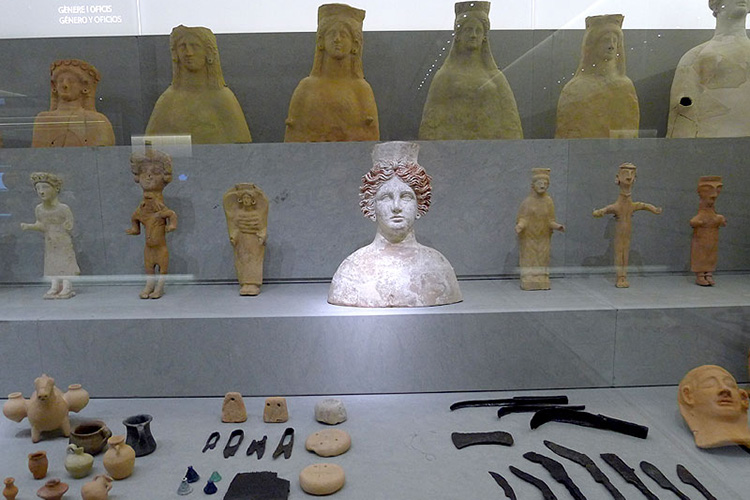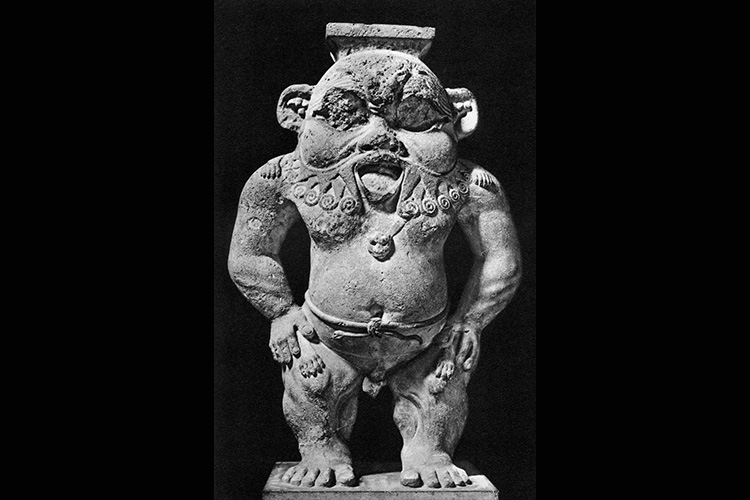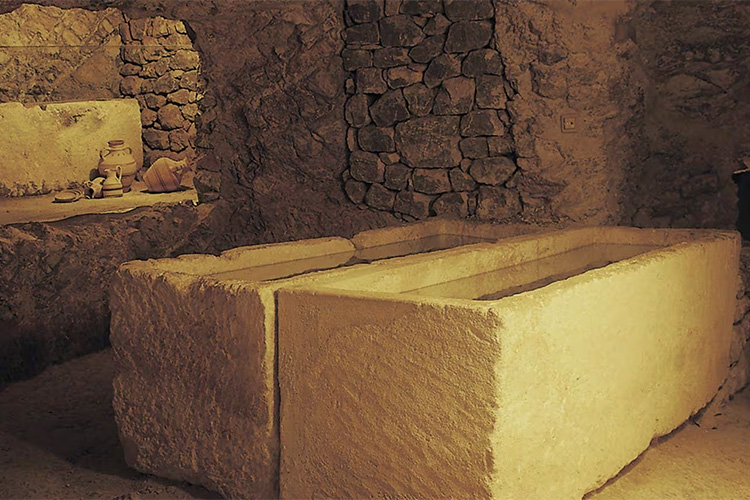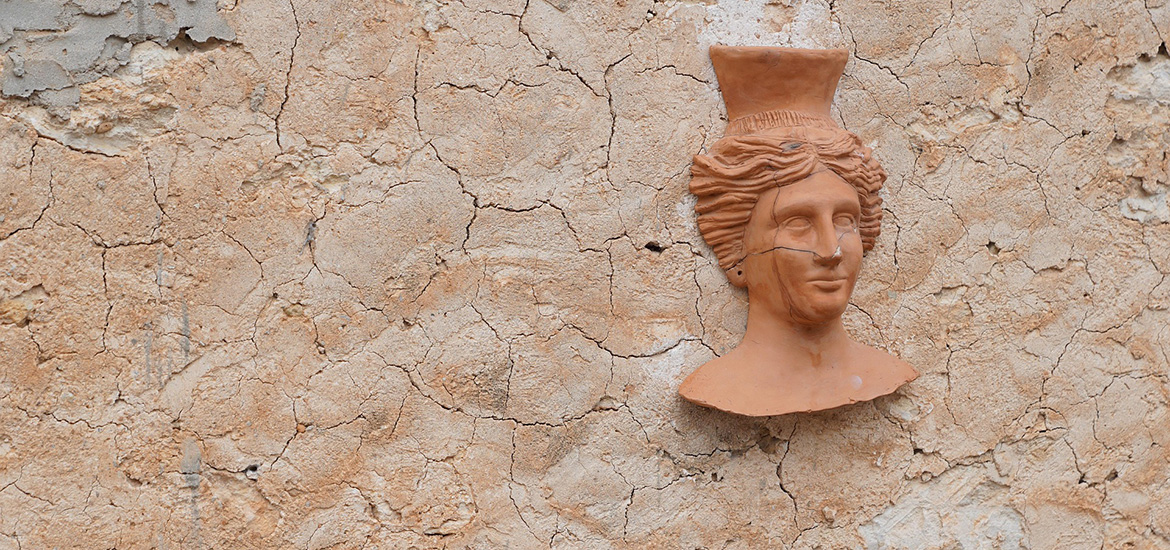Tracing the Phoenician stamp on Ibiza: their deities
Tracing the gods worshipped on the island is no easy feat, as there are very few references in classical literature and researchers have had to resort to the ancient coins, figurines and tablets unearthed. Out of all these archaeological artefacts, the most informative one is the bronze tablet found in the Es Culleram cave in 1907. This cave was a Punic sanctuary near Cala Sant Vicent and was a place of worship in the 1st century BC. It is thanks to this tablet and other inscriptions found through the Punic-Phoenician digs on the island that we now know the gods worshipped in Ibosim.
The goddess Tanit
Tanit (or Tanith) was the chief goddess of the Phoenician settlement of Carthage (Tunisia) and also of Ibiza. She was invoked for fertility, protection and war and her symbols are the dove, pomegranate and lion. She was widely worshipped in Ibiza, as we see in the archaeological artefacts uncovered in the Es Culleram cave. In fact, along with the tablet, archaeologists found many votive objects, like terracotta figurines depicting the goddess Tanit, amulets, fragments of pottery and ritual elements. These finds confirmed the extent to which the goddess Tanit was worshipped in Ibiza during the Phoenician era. Choosing a cave as a sanctuary was not by chance: in many Mediterranean cultures, grottos were considered portals to the spiritual world.
Nowadays, goddess Tanit continues to be seen as a symbol of the island. Her influence has gone beyond the Punic era and she has become part of today’s popular culture. From jewellery inspired by her iconography to references in local art and music, goddess Tanit continues to be considered a protective spirit of Ibiza.
 Tanit godness, at the museum located inside the Puig des Molins Necropolis. © Turisme d'Eivissa
Tanit godness, at the museum located inside the Puig des Molins Necropolis. © Turisme d'Eivissa
The god Melqart
This deity, who is also mentioned on the Es Culleram tablet, is a sea god watching over seafarers and trade. His presence in the Es Culleram cave is not by chance, as this grotto is next to the natural port of Cala Sant Vicent.
The god Bes
Founded in the 7th century BC, the city of Ibiza was established by the Phoenicians as a strategic spot on their trade routes across the Mediterranean Sea. They called it Ibosim in honour of the god Bes, a guardian deity linked to fertility, music and dance. In Phoenician iconography, Bes was depicted as a peculiar bearded dwarf with short crooked legs and a feather headdress holding a snake. Seen as a guardian against evil spirits, this deity was widely worshipped in Ibiza and his image has been found on coins and amulets on the island.
The goddess Demeter
Quite a few representations of this deity have been found in Ibiza but she is often mistaken for the goddess Tanit. Her symbols are the pomegranate, torch and pig as gathered from the many terracotta sculptures found in the Punic-Phoenician necropolis of Puig des Molins, the largest in the Western Mediterranean region.
Other gods worshipped in Phoenician Ibiza
In addition to the deities above, the Es Culleram tablet and other archaeological artefacts lead us to think that other Phoenician gods and spirits were worshipped, including Eshmun, the god of healing; Resheph, a war god whose symbols are the axe, lance and shield; and Baal-Hammon, the chief god of the Carthage pantheon whose symbol of the ram appears on coins unearthed on the island.
 The God Bes.
The God Bes.
Phoenician tour across Ibiza: archaeological sites
If you’d like to trace the Phoenicians, these are the archaeological sites to include on your tour of the island. Two of them, the Puig des Molins Necropolis and the Phoenician site of Sa Caleta, have been declared UNESCO World Heritage sites along with Dalt Vila and the posidonia oceanica meadow stretching between Ibiza and Formentera.
Punic-Phoenician Necropolis of Puig des Molins
The Phoenicians believed in life after death as we can see from their funeral rites. One of the most remarkable sites of this period is the Puig des Molins Necropolis, the largest Punic-Phoenician cemetery in the Mediterranean, with over 3,000 graves and hypogea. You can visit several of them as well as the museum with its collection of funeral artefacts, like amulets, jewellery and pottery.
The necropolis was the cemetery for the main Phoenician settlement on the island, located in what is now Dalt Vila. From this strategic location, the Phoenicians could control the trade of salt, pottery, metals and other goods. Their houses were laid out around central patios and were built in a simple but functional style.
Archaeological site of Sa Caleta
Another key site is Sa Caleta, an ancient Phoenician settlement between Es Bol Nou beach and the natural port of Sa Caleta, from which it took its current name. Through the ruins discovered at this archaeological site, archaeologists estimated that it was a large village built in the 8th century BC and was only inhabited for half a century, but where the Phoenicians built communal ovens, furnaces and warehouses.
Archaeological site of Ses Païsses de Cala d’Hort
This site is a window into the Punic-Phoenician history of the island. Located on the south-western coast by the beautiful cove called Cala d’Hort, the Ses Païsses de Cala d’Hort site was a settlement inhabited between the 5th century BC and the 8th century AC, during the Punic-Phoenician, Roman and Byzantine periods. Its strategic location on a hill overlooking the sea was useful for protection purposes and to control the sea routes and trade, especially products like salt, which was one of Ibiza’s greatest resources. From its Phoenician history we have the ruins of a Punic necropolis made up of twenty hypogea. The archaeological digs uncovered many artefacts of Punic-Ebusitan pottery.
 The largest Punic-Phoenician cemetery in the Mediterranean. © MACE
The largest Punic-Phoenician cemetery in the Mediterranean. © MACE
The Phoenician heritage in the landscape: the payesa house
As you drive along smaller roads and lanes across Ibiza, you get to see many examples of the island’s traditional country houses called payesa houses, one of the iconic elements of its countryside. Although these country houses have evolved over the centuries under the influence of different cultures, as we mentioned in a previous post about Ibiza’s payesa houses, the Phoenician heritage plays an important role in its design and functionality. This influence is especially visible in its layout and adaptation to the Mediterranean environment.
Payesa houses, in the same style as Phoenician constructions, are structured by modules, annexing rooms as the family expands to the original rectangular floor plan. This flexibility was typical of the Phoenician architecture, which designed its spaces to be functional and be extended as the family grew. This method meant that houses would extend organically around a main piece (usually the hearth or kitchen) to which new rooms and storage rooms were gradually annexed. They also have thick walls, small windows and flat ceilings built with juniper wood, a Phoenician technique used to build strong flat ceilings from which they often hung produce to dry.
The Phoenician influence on the payesa house gave way over time to other cultures that landed on the island, including the Carthaginians, Romans, Arabs and Catalans. Each of these people shaped the style of these houses in some way or other, but the pragmatic and climate-focused base introduced by the Phoenicians still remains to this day.
 The Phoenician heritage plays an important role in its design and functionality. © Consell d'Eivissa
The Phoenician heritage plays an important role in its design and functionality. © Consell d'Eivissa
Main picture: Tanit. Pixabay





